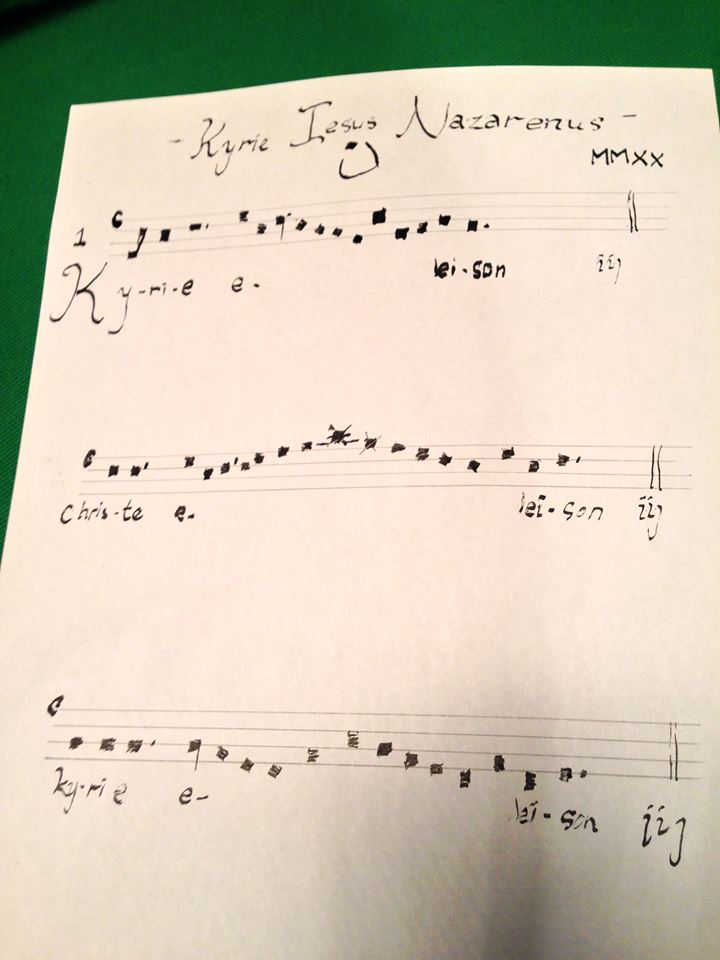Kyrie Iesu Nazarenus
-
Pax tecum!
this is my first time making chant music,
if you have insight when see / listen, please help me,
critic and comment are very appreciated
https://soundcloud.com/jefflokanata/kyrie-iesus-nazarene/s-3I9tW
(sorry the recording is awful, i cant sing properly)
it was inspired from Martyred and Slaughtered Christian by ISIS
the contour of melody is mimic the arabic word 'nun'
I dont have any app that can make gregorian note , and I use mac , could you help me?
Thank you
 Thanked by 1M. Jackson Osborn
Thanked by 1M. Jackson Osborn -
You can use the Gregorio application to make chant scores.
For simple cases, you don't even need to install it on your machine; you can use it through a web site.
For information on Gregorio, see;
* the documentation site http://gregoriochant.org/
* the on-line Gregorio editor: http://illuminarepublications.com/gregorio/
* a tutorial: http://gregorio-project.github.io/tutorial/tutorial-gabc-01.html
* a reference sheet for Gregorio's "gabc" code to represent scores: http://gregoriochant.org/dokuwiki/doku.php/cheat_sheetThanked by 1jefflokanata -
Here's some gabc code to get you started. Sounds nice; just a few observations:
(i) I've substituted some note shapes to make it look prettier, especially in the descending scale figures. YMMV.
(ii) "le-i" in "eleison" is usually taken as two syllables.
(iii) Comparing the sung version with the manuscript above, there appears to be a missing note in the manuscript for the last "eleison".
(iv) You might consider a variation for the last repetition of "kyrie eleison".
Thanked by 1jefflokanata -
Although the "ei" in the word "eleison" is treated as two syllables in the Vatican ed., in most medieval manuscripts it is treated as one. The Greek letters are epsilon-eta (short E followed by long E). Doesn't it seem acceptable for the modern composer to take his choice in this matter?
-
Agreed. But in the accompanying sound file, it is sung as two. (Unless I am going deaf, which is a possibility). The point that I didn't make very well, is that if you want it sung as two syllables it is helpful to notate it as two.
-
After reading the handwritten score and transcribing it to GABC, I listened to the recording. Here is the code for that transcription:
name: Kyrie Iesus Nazarenus;
commentary: MMXV;
annotation: i;
%%
(c4) KY(dh)ri(g)e(h.) *() e(ighv.GFEDgde)lei(f)son.(e.) <i>iij</i>() (::)
Chri(h)ste(h.) (,) e(igh.h!ijkvJIHGi)lei(g)son.(h.) <i>iij</i>() (::)
Ky(f)ri(f)e(f.) (,) e(fvEDCegFEDCe)lei(c)son.(d.) <i>iij</i>() (::)
While the recording did not quite seem to match the written score (as transcribed by me), I felt that there indeed needed to be a separate syllables for the "lei" in "eleison"; i.e. "e-le-i-son" rather than "e-lei-son". However, my take on modifying the score is different from Gregory's. So I came up with the following solution: move "le-" to the note preceding the former "lei-" syllable (which now becomes the "i-" syllable):
name: Kyrie Iesus Nazarenus;
commentary: MMXV;
annotation: i;
%%
(c4) KY(dh)ri(g)e(h.) *() e(ighv.GFEDgd)le(e)i(f)son.(e.) <i>iij</i>() (::)
Chri(h)ste(h.) (,) e(igh.hiwjkvJIHG)le(i)i(g)son.(h.) <i>iij</i>() (::)
Ky(f)ri(f)e(f.) (,) e(fvEDCegFEDC)le(e)i(c)son.(d.) <i>iij</i>() (::)
By this point, I felt that the "Christe" and second "Kyrie" were not quite right (to my own taste), too short; hence, I modified the code even more to produce the following:
name: Kyrie Iesus Nazarenus;
commentary: MMXV;
annotation: i;
%%
(c4) KY(dh)ri(g)e(h.) *() e(ighv.GFEDgd)le(e)i(f)son.(e.) <i>iij</i>() (::)
Chri(hih)ste(h.) (,) e(igh.hiwjkvJIHG)le(i)i(g)son.(h.) <i>iij</i>() (::)
Ky(h)ri(ef)e(f.) (,) e(fvEDCegFEDC)le(e)i(c)son.(d.) <i>iij</i>() (::)
Finally, after singing through the results several times, I felt that the "le-" syllable (which has the accent or emphasis in pronunciation of "eleison") should carry the bulk of the melisma that the "e-" syllable had been given. So I moved "le-" up in each case and added one more note to the first syllable of the second "Kyrie", obtaining the following (which I like best of all):
name: Kyrie Iesus Nazarenus;
commentary: MMXV;
annotation: i;
%%
(c4) KY(dh)ri(g)e(h.) *() e(igh.)le(hvGFEDgd)i(ef)son.(e.) <i>iij</i>() (::)
Chri(hih)ste(h.) (,) e(igh.)le(hiwjkvJIHG)i(ig)son.(h.) <i>iij</i>() (::)
Ky(hg)ri(ef)e(f.) (,) e(fvEDC)le(egFEDC)i(ec)son.(d.) <i>iij</i>() (::)
The four attached PDFs give, in order, each of these versions. They represent my own thoughts on possible modifications of the original and may be freely used or even modified by those who have still different ideas.
Thanked by 1jefflokanata -
@adam wood
haha , yes that mistake! I confuse when make date of composition , century and year .
@CHGiffen
wow thank you very much ! thank you!
@bruce
I did not know that
@gregory
at first, I compose it at piano , then wrote , and then sing it .. but when I sing, I make variation
Thanked by 1CHGiffen
Welcome to the MusicaSacra Forum!
To participate in the discussions on Catholic church music, sign in or register as a forum member, The forum is a project of the Church Music Association of America.
Categories
- All Discussions21,097
- General Music Discussion7,589
- Job Openings1,300
- Management of Music Programs833
- Choral Matters519
- Church Documents and Rubrics503
- CMAA Notes291
- Events651
- For Newcomers: Read First23
- Sacred Polyphony528
- Hymnody821
- Gregorian Chant: General2,582
- ↳ Graduale Romanum and Liber Usualis354
- ↳ Graduale Simplex55
- ↳ Semiology57
- Vernacular Plainsong671
- Anglican Use and Anglican Chant66
- Organ, Other Instruments and Repertoire414
- New Composition/Works in Progress1,208
- Recordings222
- Music for Hispanic Ministry151
- Music Education: Children205
- Music Education: General214
- News Items242
- Positions Wanted58
- General Discussion: Catholicism723
- Amusements170
- General Discussion1,000
- Opinions113






